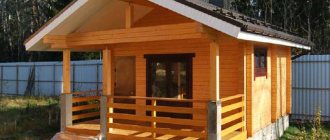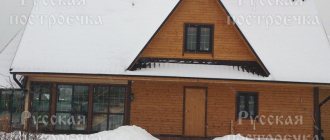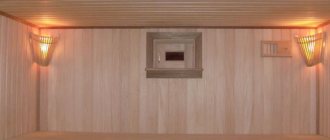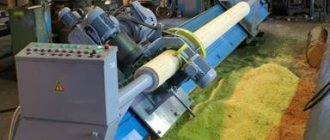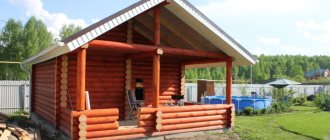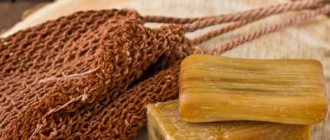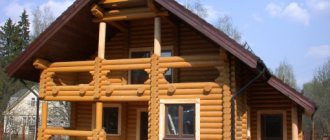The construction of a Russian bathhouse is traditionally carried out from wood of various species. But not all types of wood are suitable for building a bathhouse, so it is important to understand and understand which ones are better to choose. What kind of wood is best to build a bathhouse from, which one is suitable for finishing, we will find out why with our readers.
The wood for building a bathhouse is different. Each has its pros and cons.
How and by what parameters to choose
Deciding on the project
As I wrote above, I would like a bathhouse with an attic. This is the first requirement. Initially, I planned to build a bathhouse with a 6x6 attic. But due to the requirement to build structures on the site no closer than 3 meters to the fence, such a bathhouse size would leave little space on the site (I also have a house, a garage, garden beds and a playground). However, in contrast to this I would like to have in the bath:
- spacious lounge
spacious attic
- separate shower room
- steam room
- separate hallway
Choosing a foundation
It all depends on the soil and the weight of the structure. For most soils and buildings, the choice of a shallow strip foundation made of monolithic reinforced concrete will be universal. It is also possible to choose the most reliable slab reinforced concrete foundation or the more economical screw piles. I settled on a universal tape.
Second tip
:
Selecting wall material
There are the following types of bath walls:
- from rounded logs
from laminated veneer lumber
- from profiled timber
- using frame-panel technology
Roof selection
In fact, it's a matter of taste. I chose metal tiles because of the price-beauty ratio. A more budget option is roofing felt. More expensive, but aesthetically pleasing - soft roofing. Fourth tip
:
Metal tiles
Budget
This is probably the most decisive factor. Everyone should decide how to save on building a bathhouse. In my version, a turnkey bathhouse with electricity, plumbing and heating connections cost around 900,000 – 1,000,000 rubles
! Not bad. What can you save on?
- Foundation – strip – pour it yourself/hire people. Piling – screw in piles with a friend. Savings from 100,000 rubles.
It will be difficult to install the walls of the log house yourself, so you can only save on the type of material. Frame and rounded logs are the most economical options. Savings from 150,000 rubles.
- Roofing - if you are interested in the roofing budget, then roofing felt will cost about 50,000 rubles, ondulin - 120,000 rubles, metal tiles - 130,000, soft roofing - 150,000 - 200,000 rubles. The choice is yours. For me, metal tiles are a universal option.
Therefore, I still settled on the average choice of the 6x5 project.
As you can see, everything is there. Therefore the first advice
for choosing a log bathhouse project:
Personally, I didn’t doubt it for a second - the bathhouse should be made of rounded logs. Glued laminated timber is expensive, frame-panel technology is not for baths. The bathhouse must “breathe”. Profiled timber is a matter of taste. I wanted a log house (or rather, a log house). Third tip
Rounded log
Total, according to my calculations, you can save from 200,000 to 400,000 rubles
.
Fifth tip
:
Look for ways to save money.
So, decide for yourself how to choose a bathhouse. I gave you the main factors using my example. Good luck!
Let's start with the foundation
It is precisely the foundation that least of all depends on the personal aesthetic preferences of the owner.
The combined mass of walls, ceilings and roof presses on it from above, and soil tries to push it out from below. What are the conclusions from this? To choose a suitable foundation (see here about their types), you must already know what kind of walls and roof you want to build. Some varieties will be light, others heavy.
For example: a brick bathhouse, made of foam blocks, a two-story bathhouse, made of thick logs, with ceramic tiles - there is no chance of getting by with a shallow columnar or strip foundation.
But this is on the one hand. On the other side we have soil. With its heaving (frost heaving is when water expands when it freezes, the soil increases in volume and begins to press and squeeze out everything that is in the ground, for example, the foundation), freezing depth (for critical buildings, the depth of laying the foundation should be lower than the freezing depth of the soil ), groundwater level (it is always desirable that the foundation be above their level, otherwise - drain).
BY THE WAY! After winter heaving, the ice melts and the soil begins to draw in, “drown” the foundation. Such are its seasonal fluctuations.
In addition to the above, it (soil) also has a type of soil - it determines whether the building will be stable. There are quicksand sands on which piles are placed, and deeper ones. And there are quite decent clays with decent heaving, which a slab foundation can withstand (it seems to “float” on the soil surface, like a raft on water).
The third factor is terrain. If the height difference in the designated building area is significant, and it cannot be leveled using equipment at a reasonable cost, then the best material for the foundation of a bathhouse in this case will be piles.
The fourth factor is budget. Some types of foundations are expensive, others not so much. Slab will be expensive. Steel piles for great depths also cannot be called cheap. The most budget option is or. They require little material, but the circumstances listed above should be favorable.
Useful links on the topic:
- What is the “bathhouse foundation height” and “laying depth”? What to consider?
- How to make a bathhouse foundation from blocks: what choice do we have and what does it depend on?
- Foundation for a frame bath
- With your own hands: how to make a foundation for a bathhouse? Step by step instructions here
- It's time to make a foundation for a bathhouse: which one is better will be determined by three factors
- Foundation for a bathhouse: how to make? Secrets of correct calculation, marking and creation of foundations of all types
- How to pour the foundation for a bathhouse correctly? Description of all stages of work
About the rules for harvesting logs for the construction of a log house
Harvesting is the most important process on which the condition of the log house will depend for many years. Coniferous wood is selected for the log house; rot and wormholes are not allowed. The wood should be even, preferably of equal thickness. Harvesting is carried out only in winter, at the beginning. At this moment, the moisture content of the wood is minimal, and the content of natural resin and essential oils, which are natural antiseptics, is the highest. Such a forest is much less susceptible to wood diseases.
The diameter of the logs is important when logging, minimum 220 mm, the largest is considered the best.
After harvesting, the timber is transported as quickly as possible to the place where debarking will be done.
When debarking, it is also important not to damage the top layer of the log, under the bark and bast. The inner loose layer is more exposed to the environment, and drying occurs too quickly
Because of this, the surface of such logs may end up with cracks. Carpenters say that deep centimeter cracks appear only in logs that were processed mechanically, with milling cutters or electric jointers.
After the bark is removed, it is collected and burned, since tree beetles and other unnecessary company usually live in the bark.
If trees are cut down at the beginning of winter, they can be kept without removing the bark until spring. During summer felling - no more than 15 days. The fungal disease, noticeable to the eye as the blue discoloration of the trunks, begins to progress when the air warms above 10⁰C. When selling timber, they always tell buyers about the complete harmlessness and ubiquity of “blue stain”, but it is still a disease, and it is better to do without it.
After the logs are debarked, they are stored in stacks with ventilated intervals of 4-5 cm for ventilation and drying. The stacks are assembled on scraps of logs or thick boards with wedge stops at the ends to prevent the logs from rolling out. Under the stack you need waterproofing - a layer of thick polyethylene film or any other rolled material.
The logs in the bottom row are preferably of the same diameter. The next row of logs is laid on boards attached to the logs of the bottom row. The boards should be no thinner than 80 mm. The stack structure must be rigid and fixed in both directions. A gable roof is installed on top of the stack to protect from rain and snow. To make it more convenient to take logs to the log house in the future, thin logs are placed below, and the thickest ones are placed in the top row.
After laying the stack, all log cuts are coated with bitumen, PVA glue or clay so that drying occurs evenly along the entire length of the trunk.
If you plan to make a log house without compaction between the crowns in order to disassemble and re-arrange it permanently in six months or a year, then you can start cutting from undried logs. But if you are cutting a log house for a permanent place, immediately with inter-crown seals, then you need to take logs that have dried in a stack for at least 1 year.
Everyone understands that if you cut it from a damp forest, and in order to avoid the problem of mold and mildew, do a copious antiseptic treatment, there will be no particular benefit from such a tree. In addition, it may not help, since the wood, which has moisture inside, cannot be saturated with an antiseptic; it will only affect the top layer of the log. Even worse is to varnish raw wood, even with antiseptic treatment. This is a sure way to create conditions for the rapid spread of rot in the inner layers of the tree. The service life of such a log house can be approximately estimated at 15-20 years, in conditions of constant deterioration in environmental friendliness and safety. Drying logs to “equilibrium” moisture content should take at least two years, this is the traditional technology. And if you follow it, then you will not see cracks in the walls, strong shrinkage of the house and various cracks in the corners in your house, as well as wood diseases. A wooden frame can last more than 100 years; this has been proven over centuries of construction practice. Will serve both children and grandchildren.
The next topic is about the design of the log house and cutting methods.
Is it necessary to caulk?
The traditional method of insulation is laying moss during the construction of a log bathhouse. Moss has been used for centuries and remains popular today, despite the variety of new materials on the market.
The installation of inter-crown insulation is carried out after the logs are finally fitted. The stages of its installation are as follows:
- The moss is laid out across the log in a layer of up to 2 cm; there is no need to compact it. The main thing is that there are no unnecessary details in the layer in the form of bumps or knots. The moss should be laid out 5-10 cm wider than the width of the longitudinal groove of the top log. The fibers must be placed in the bowl so that the moss protrudes from it by 5 cm;
- the compactor is laid out so that the joint of the logs is filled evenly;
- after laying the moss, a log is placed on top so that the moss does not move;
- the laid material is tapped for normal shrinkage.
With a good and high-quality fit, 1-12 m of inter-crown connection will require about a standard bag of dry moss.
By the way, you also need to remember that in a year you will need caulking again, since within a year the log house will settle and the moss will settle down.
General description of a log bathhouse
Information.
A log bathhouse is good because its walls heat up faster, breathe, and absorb moisture. It is easier to maintain the desired microclimate in a log structure.
The logs of adjacent crowns are joined along a semi-cylindrical surface 12–14 cm wide. The joints are closed from moisture, since the groove is selected from the underside of the log. Carefully caulked, they do not become bridges for heat escape. The connections of crowns in bathhouses made of chopped logs are insulated with moss, linen tow, jute tape, felt).
The log must be a construction log (for construction), and not a saw log (for creating lumber). For a bathhouse, a “twenty” log is often chosen, less often a 24-centimeter log.
Dimensions, diameters and cutting features
For even laying, it is better to use cylindrical rather than cone-shaped logs. There are three types of barrel processing:
- Rounding,
- Planing,
- Scraping.
The most even log is obtained by rounding. This method is also the most economical. It is important that during processing the wood is dried according to certain rules.
With the planed version, you need to adhere to the rule when laying logs: for each linear meter, a change in diameter of 1 centimeter (taper) is allowed. In the scraping version, all the flaws remain. There is no elimination of barrel curvature. You should prefer only the first two processing options when choosing logs for a bathhouse.
The design is directly affected by the uniformity of the logs. Linear dimensions in all cases depend on the overall design and climatic conditions. Thin logs are suitable for a summer bath, but not for an all-season bath.
If the structure is planned to be used all year round, you should choose log diameters in the range of 22-28 centimeters. In cold climates, the recommended diameter of logs is up to 36 centimeters.
There are a large number of ways to cut logs. Most popular:
- Bowl,
- Paw,
- Norwegian and Canadian logging,
- With a tail groove,
- To the gun carriage,
- The ridge is in the groove.
Masters recommend stopping at a cup or paw.
Popular cutting methods and their features
Protection of log walls
They place a log bathhouse on (with a base half a meter high) or on screw piles.
To protect the logs from getting wet, the foundation is made ventilated - vents are installed on all sides (they are closed for the winter). They don’t skimp on roof overhangs. The larger the overhangs, the better. And the higher the bathhouse, the longer the overhangs will be required.
It is worth remembering that the distances between buildings are the distances between their projections on the ground.
Important! The minimum possible distances between buildings and trees are calculated by specialists and specified in regulations. Their compliance is checked by public services and local authorities
The aspect of fire safety has rightly received special attention. The most important thing is to maintain the distances between wooden structures (or if at least one of them is wooden).
There are distance standards that apply specifically to bathhouses, regardless of the material (for example, from a bathhouse to a poultry house). The maximum of all values must be observed.
A log bathhouse is treated with an antiseptic and fire retardant. The floor, the joists for its flooring, and the lower crown - under the floor - are especially carefully protected.
After using the bathhouse for its intended purpose, it is well ventilated.
Installation
We adjusted the crown and marked the centers of the holes for the dowels. Using a drill or a drill, we drilled holes in the three upper rims and drove in the dowel. And so on until the very top crown.
If inter-crown insulation is installed during installation, it will wrap around the drill during drilling. To prevent this from happening, make a gap in the insulation where the drill will go through. During the final caulking of the bathhouse frame, this place can be sealed.
After the last crown has been laid, you can proceed to the following actions: install the lower and upper floors, make door and window openings in the walls, truss the roof and erect internal partitions.
Which log house is better for a bathhouse?
Log buildings vary in total area and number of floors. For a bathhouse, they often prefer a small one-story log house with a terrace, the area of one floor is 30–50 m2.
Logs for log houses can be hewn (planed) or galvanized (with the outer layer cut to a given diameter).
In what ways does it lose to hewn:
- cracks appear earlier and larger;
- the log house looks unnatural;
- processing technology removes the densest sapwood;
- wood quality indicators visible on the outer layer are hidden;
- processing technique - with a miter saw, a milling cutter - makes the wood more vulnerable, the log rots and collapses more quickly (an ax and a plane do not saw, but chop, not “shaggy”, but flattening the fibers);
- requires more impregnation consumption;
The main advantage of logs that have gone through a rounding machine is the speed and ease of erecting walls.
Semicircular joints of the same width are not blown through and make the wall more stable.
As a result, the owner receives a beautiful log bathhouse, which does not require additional wall cladding.
But the performance qualities of a log house are much higher if the cambium of individual logs is manually trimmed (the layer immediately under the bark, hygroscopic and attractive to bugs).
In this case, only 1-2 annual rings of the sapwood (the layer between the core and the cambium) should be captured, and the surface should be well sanded.
Information.
The plane removes too thick a layer of wood. A scraper is a more gentle tool designed specifically for this operation.
Shrinkage
When freshly cut, wood contains a significant amount of moisture. Free moisture is found in wood cavities. Leaving the material, it does not affect its shape and linear dimensions. Bound moisture is another matter - that which is present in the thickness of the cell membranes. Its content in wood reaches up to 30% and removal entails warping, cracking and shrinkage (reduction in linear dimensions) of the timber.
During construction, you will have to add 5–7 cm for each meter of height to the expected height of the bathhouse from the log house. The allowance for sedimentary deformation is also included in the height of door and window openings. The gap above the box is temporarily filled with insulation, and after two years it is caulked or covered with an additional element (if the shrinkage was less than expected).
Installation of internal partitions (non-shrinkable) and cladding are timely only one to two years after the construction of the log bathhouse for shrinkage from logs. The period of “rest” depends on the size of the log house and the weather.
For a small bathhouse, 10–11 months of settling may be enough - if construction began after the autumn rains and the summer was dry.
Attention! The gap between the partition and the ceiling is required even after drying, at least 1-2 centimeters.
Horizontal shrinkage - along the wood fibers - is only a few tenths of a percent, so when building a log bathhouse, no attention is paid to lengthwise shrinkage.
A bathhouse can be built from brick, but many people see a log house as a “historically correct” solution.
If you say the word “bathhouse”, then most likely an image of a log house will appear.
In order for log houses and bathhouses to serve for a long time, the work of professional carpenters, assemblers, roofers, healthy timber and their competent processing are needed. Proper use will prevent early cracking and twisting of the wood.
How to choose a log house for a bath
The construction of a log house is possible from forest materials of coniferous and deciduous species. The types of wood allowed for use and the parameters of building materials made from it are prescribed by state standards.
Conifers
The buildings are erected from pine, spruce, fir and larch logs of grades 1 and 2, average thickness - 14–24 cm, length 3–6.5 m. You can often find a wild log bathhouse - this is when the logs can vary greatly in diameter from crown to top crown, the projections of logs from the walls may also differ. All this creates a picture of the chaotic nature of the construction of the log house, but at the same time it makes the construction more natural, more natural.
It is impossible to build a log bathhouse from cedar due to the fact that when heated, this tree releases substances hazardous to health into the air!
Traditionally, resinous, soft, warm species are used for a coniferous log bathhouse - pine and spruce. One or two lower crowns are made of larch - harder, denser and more durable. (Larch also goes on beams - under the floor and under the rafters).
Information.
It is more pleasant to steam in a spruce bath, and healthier in a pine one. Spruce removes excess moisture well, while pine breathes better. In terms of durability, one is not inferior to the other.
Building a bathhouse from larch will cost more (due to the higher price of the material and labor - larch is difficult to process). The walls of the bathhouse will be colder (almost a third) and heavier. The smell of this wood when heated is not to everyone's taste.
But the fire resistance of larch is twice that of pine. It tolerates high humidity much better than other breeds and is not inferior to rounding. (The core of its trunk is strong and moisture-resistant, the sapwood is weaker and very narrow).
Hardwood
For a log house made of deciduous wood, grade 2 logs with a thickness of 12–24 cm and a length of 4–6.5 m are suitable.
Moreover, if the walls of the log house are designed to be longer than 6.5 m, then the design is complicated by internal capital partitions.
Baths are built from the trunks of maple, birch, aspen, poplar, linden, willow, beech, elm, and hornbeam.
Ash is not suitable for wet areas. Oak is used for the crown molding (and floor joists).
Aspen is considered ugly and too soft (it grows quickly and does not have time to gain strength). The tree gains a thickness suitable for construction late, when the trunk begins to collapse from the inside. But if the aspen was felled healthy, it remains strong for a long time. An unsightly, but useful protective film for the wood is formed on the surface of the planed log. As a result, aspen:
- not afraid of humidity;
- flammable;
- unattractive to most pests;
- sold at a low price.
Log cabins made of aspen are common: you can buy a large amount of wood, select commercial logs, and use the rest for firewood. After sanding, the aspen log house looks decent, and the steam in the aspen steam room is “softer” than in the log bathhouse made of pine.
An aspen bathhouse does not “breathe” well; the room requires proper ventilation after its intended use.
Linden is similar in roughness and softness to aspen, but is susceptible to rotting. They build linden log cabins from logs with their own hands because of the unique aroma of wood. As a last resort, only the top crowns, or only the shelves, are made linden - they do not heat up as much as those made from dense wood.
Birch is harder than aspen and linden and less prone to rotting during growth. Birch wood warms up better.
Internal angle when cutting in the paw: half-carriage, round timber 45º, half-bowl
We decided to put this article on the main page, because with almost everyone who wants to buy a log bathhouse, we discuss how to cut internal corners. When cutting into a bowl (the remains of the log stick out beyond the dimensions of the building), in 99% of cases a round log remains inside the room. But when cutting with the paw, everything is not so clear.
Semi-carriage
- the most inexpensive option. Let us immediately note that in the old days logs were hewn with an axe. In modern budget wooden architecture, the half-carriage is cut with a saw in continuation of the inner edge of the paw. If the wall is covered with sheathing, then we definitely choose this method of treating the inner surface of the walls. It also looks good if you sand the inside of the wall. In addition, the maximum usable area remains. As a rule, the walls in the steam room are sheathed (with non-coniferous clapboard so that they do not resin when heated) and in the washing compartment (with something waterproof, for example, plastic panels). It’s not hard to find a photo of a semi-carriage, so we’re not publishing it here: just flat walls and a right angle.
Round timber 45º
- for those who want to buy an inexpensive sauna and at the same time leave a round log inside the room. In this case, only the corners of the log cut are adjusted, but the semicircular fit of the corner rims is not made. In addition, it is easier to select logs, since a difference in the diameters of adjacent crowns is allowed up to 4-5 cm, without damaging the structure. During finishing work, the corners are coated with sealant or pierced with hemp rope, which covers the inaccuracy of the fit.
Half bowl
- the most expensive option when cutting corners with a paw. The selection of logs by diameter is the same as when cutting into a bowl. The crowns match each other perfectly from the inside, each one fits each other. Outside there is a traditional warm corner - a paw with a root spike. In terms of complexity, half-bowl cutting is somewhat superior to bowl cutting, but due to the fact that the logs used are shorter, such log houses cost a little less.
Processing logs for logs
The basic rule for building a log house is to process it exclusively with hand tools. It is clear that this rule is not always possible to follow. Nowadays, log houses are mostly not cut, but “sawing”. Not only the preparation of wood, but also the selection of a longitudinal groove and the processing of corners is done with a chainsaw. And this is understandable, the speed of construction should be as high as possible, and labor costs lower. But you need to know that with this method of processing, the capillary fibers of the wood, in which moisture accumulates, remain open. The resulting saw cuts continue to absorb and accumulate moisture. The internal moisture content of such logs will be higher than that of chopped logs. At the same time, heat loss and the risk of rotting and damage by mold and mildew increase.
When processed with hand tools - an axe, chisels, scrapers, planes and jointers, the wood capillary tubes become clogged and can no longer take in and accumulate water. As a result, the log house retains heat better and suffers significantly less. Modern craftsmen choose the best of two technologies - they save their time and labor by working with power tools and a chainsaw, but leave a few centimeters to the marks. And then they do the cutting using an ax and hand tools, closing or “plugging” the capillaries of the tree. Experts say that with this method of work, wood cuts do not differ from those processed by hand.
Modern wood materials have many advantages. Calibrated (rounded) logs, profiled and laminated veneer lumber have valuable advantages and excellent appearance. But they lack one unique property compared to a solid log. During processing, the integrity of the tree is violated, the resistant outer layers are removed and the looser inner layers are exposed. Subsequently, in order to achieve the necessary resistance to external factors, wood is periodically treated with biostability compounds, which does not make the wood more environmentally friendly, on the contrary. However, there are also folk safe and useful methods and means of processing; the only negative factor is the time factor.
A special unique property of coated wood is its high resistance to diseases.
Buildings made of slag, gas and foam blocks
Which blocks are best to build a bathhouse from? Let's try to understand this issue in detail. Is it worth using blocks to build a bathhouse at all?
Foam block
The main advantages of such materials include low cost and speed of construction. But the service life of block buildings is significantly lower than that of wooden or stone ones. A bathhouse made of slag or foam blocks will cost 2 times less than a wooden one.
However, taking into account the finishing, the savings will not be that big. After all, such a building will require additional waterproofing and insulation.
Bathhouse made of cinder blocks
Cinder block building
Bathhouse made of cinder blocks
Cinder blocks are made from pelite, ash or slag. Less commonly, gravel, crushed stone, and sand are used as filler. You can erect a building from large blocks (their standard size is 390x190x188 mm) in a matter of days. Moreover, cinder blocks are often made at home, even in the absence of special equipment. Thus, the final cost of the building will seem to be lower.
But for a bathhouse, it is the finishing that will be the decisive factor - not only internal, but also careful external cladding will be required. Products made from cinder blocks without it will quickly absorb moisture. Therefore, before you start building a bathhouse from blocks, calculate the final cost of not only the foundation, walls, floor, ceiling, but also the finishing.
Building made of aerated concrete blocks
Laying aerated concrete blocks
Building made of aerated concrete blocks
Aerated concrete is concrete that has a cellular structure. In addition to sand and cement, it contains special gas-forming agents that foam the solution. Due to the appearance of air bubbles (pores), the material acquires increased heat-shielding properties.
Aerated concrete is much easier to process than regular concrete. It can be sawed and drilled. A nail can be driven into a wall made of aerated concrete without any effort. A significant drawback of the material, just like cinder concrete, is its rapid destruction when wet. Therefore, buildings made from it require waterproofing.
The weight of the blocks is significant, so the laying will have to be done by two people
You need to work with blocks carefully - they are quite fragile
Distinctive features of buildings made of foam blocks
Production of foam blocks
The composition of foam and gas blocks is quite similar. So what material is it better to build a bathhouse from? If aerated concrete is produced in autoclaves under high pressure, then foam blocks are produced using conventional formwork. During production, the solution is poured not into molds, but into ordinary formwork.
Hardening occurs under natural conditions at low positive temperatures. It takes longer for foam concrete to harden – up to 28 days.
The shape of the foam blocks is far from ideal - the products are loose, with slight deviations in height, length, and width. Naturally, their cost is low. But their strength is lower than that of gas blocks.
Gas cylinder in the country - for a stove, heater and other needs: rules of use (Photo & Video) + Reviews
Choosing wood for a log house
A real log house is made from coniferous wood harvested in winter. Pine, oak, larch and ash are rot-resistant. Cedar, fir, larch and spruce are classified as moderately resistant. Deciduous wood is classified as low-resistant and unstable; this wood is more susceptible to insects and various diseases.
In terms of cost, cedar, oak and larch are much more expensive than pine and spruce. Pine wood is plastic, and when processing it with hand tools it is easier to avoid scuffing and chipping. Pine is a strong energy donor. Many specialists in wooden architecture consider pine wood to be the best material for modern private builders, and not only because of its cost-effectiveness. Spruce is also a good option, but it is a little more difficult to process and is more susceptible to various diseases. But the heat-conducting properties of spruce wood are higher than those of pine, and a spruce log house will be warmer than a pine one at the same thickness.
Cedar
A cedar steam room is a luxury that not everyone can afford. Today, the procurement of Siberian cedar is limited; most of this royal tree is sold to other countries. This wood is unique in its properties. Thanks to the fibrous structure, the logs do not shrink, practically do not crack or bend.
Cedar is superior to its coniferous counterparts in its resistance to high temperatures, rot and moisture. In addition, this tree is very beautiful; its logs have a noble shade and a pleasant structure.
It is also worth mentioning that cedar is a storehouse of essential oils, thanks to the evaporations of which a cedar bathhouse becomes a truly healing place.
https://www.pogreemsya.ru/www.youtube.com/watch?v=CppwS1CBawQ
Furniture
In addition to wood, which is used in the bathhouse as a building material, we also encounter it as a material for making furniture. Furniture in the bathhouse includes shelves, tables, benches, benches, armchairs, and sofas.
However, we will not touch on furniture that is usually purchased in stores or brought from home. There the wood can be anything, and such furniture is not selected according to the type of wood. See the furniture section on our website here.
But shelves are an important and necessary topic. Because everywhere they are made independently or to order, according to the size of a specific steam room. Therefore, it is useful for bathhouse owners to know what kind of wood the frame of the shelves and the shelves themselves are made from.
The frame of the shelves and the shelves themselves
As for the frame, most save money and make it from pine or spruce wood. This is a budget option that does not negatively affect the quality of the regiments.
Even if under the influence of high air temperature the frame begins to release resin, it will remain out of sight and reach. In addition, such shelves will be more reliable than if made from hardwood.
But the sheathing of the frame, of course, should be made from rocks that will not burn you. deciduous are best suited , for example, linden or aspen , or the African abash, so beloved by everyone . By the way, this is a distant relative of the linden tree.
What are the benefits of linden, aspen or abash? They have a relatively low density, so this wood does not heat up well. Conifers have record holders whose density is even lower, but they cannot be recommended, because no one has canceled the release of resin .
We have a whole section about regiments here.
Useful video
A very interesting video in which wood moisture tests are carried out and the results are unexpected not only for us, but also for the experimenters themselves . We cannot agree with the authors of the video that reducing moisture during impregnation does not matter. Has for the wood itself, its service life.
***
We advise everyone who is busy building or improving their bathhouse to subscribe to our Telegram channel - this way you will always be aware of new materials appearing on the site, and we try to make them as informative and useful as possible.
